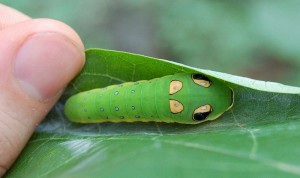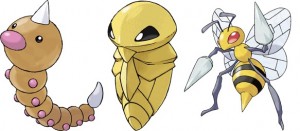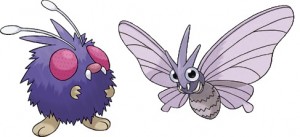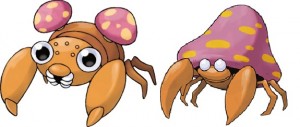Miles Zhang is an MSc student at Laurentian University who, when not trying to catch ’em all, is finishing up his thesis on the taxonomy of parasitic wasps.
————————–
Unless you’ve been living under a rock for the past decade or so, you’ve surely heard of Pokemon (short for Pocket Monsters). Released in 1996 by Nintendo under the names of Pokemon Red and Blue, this pair of interlinkable RPG (role-playing games for non-gamers) took the world by storm and has now become one of the most lucrative video game-based media franchises in the world.
Like most eleven-year-olds at the time, I was infatuated by these little fictional monsters. Every day I would run home after to catch the TV show, and boot up the Gameboy as soon as my parents weren’t watching. Sixteen years later, I have played most of the Pokemon games from all five generations, and have caught most of the 659 Pokemon.
However, this blog post isn’t about how much of a nerd I am! Rather I’d like to highlight the 65 Bug type Pokemon that have appeared throughout the series. As an entomologist, I would also attempt to match them to their real-life counterparts and briefly discuss their biology. This will be divided into 5 parts, with each post covering one generation. In a way, I guess insect taxonomists have a similar goal as a Pokemon master…Gotta catch ‘em all (or at least try)!
Bug Pokemon were one of the 15 types of Pokemon introduced in Gen I, which includes 12 of the original 151 Pokemon found primarily in Pokemon Red, Blue (Green in Japan), and Yellow version of the games.
Caterpie->Metapod->Butterfree
The inspiration behind these Pokemon are the larval, pupal, and adult stages of swallowtail butterflies (Family Papilionidae). The red horn protruding from Caterpie is the equivalent of a swallowtail caterpillar’s osmeterium, which are fleshy organs that are normally hidden. If threatened, the osmeterium can be quickly everted, which is laced with a foul-smelling secretion and used as a defense mechanism. The caterpillars of the Spicebush Swallowtail (Papilio troilus) also have large, snake eye-like markings on their thorax in later instars, creating the illusion of common green snakes. The Y-shaped osmeterium further enhances the disguise by mimicking a snake tongue. It’s too bad this was not utilized in the game, as Caterpie can only use Tackle and String Shot.
Metapod is modeled after a swallowtail chrysalis, which can often be found hanging off a branch attached via a silken pad. As time passes the chrysalis hardens (hence the Harden attack), and the adult butterfly emerges. While all butterfly wings are covered in scales and can be potentially irritating to the eyes, it cannot produce poison, paralyze or put things to sleep like Butterfree.
Now while some hymenopteran larvae such as the sawflies have larvae with multiple rows of fleshy prolegs, the larvae of stinging wasps (Aculeata) are legless and do not possess a Poison Sting like Weedle.
Venonat-> Venomoth
A gnat (Venom + Gnat = Venonat?) is the common name for various nematoceran flies, and is not related to moths.
Paras -> Parasect
While the Pokemon itself resembles a cicada nymph, the inspiration for these Pokemon might be the Entomophthorales fungus (parasite=parasect?), which enters the digestive tract and expands until it can be seen between the abdominal plates. The bloated corpses are often found with straightened legs and wings, perhaps to ensure the distribution of fungal spores.
Pinsir
Pinsir (haha get it, Pincer…oh puns) is the only non-evolving Bug Pokemon in Gen I, as Scyther can evolve into Scizor starting in Gen II (which I will talk about in the next post). Stag beetles (Family Lucanidae) are extremely popular in Japan as pets. The males of the largest species in Japan, Ookuwagata (Dorcus curvidens) can sell upwards of several million yen (tens of thousands of dollars). As the males have large and distinct mandibles and rather aggressive, they are often pitted against each other for the purpose of entertainment and frequent contestants of the ever ridiculous Japanese Bug Fights (http://www.japanesebugfights.com/).
This concludes the first part of Real Life Bug Pokemon, more to come in the near future.









Special guest post series from @eurytomid about the insect inspiration for Pokemon! http://t.co/LoY3Hd7Y
Special guest post series from @eurytomid about the insect inspiration for Pokemon! http://t.co/LoY3Hd7Y
Special guest post series from @eurytomid about the insect inspiration for Pokemon! http://t.co/LoY3Hd7Y